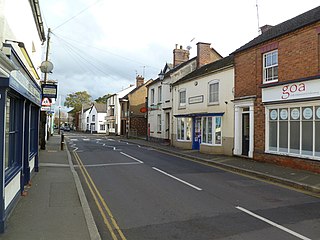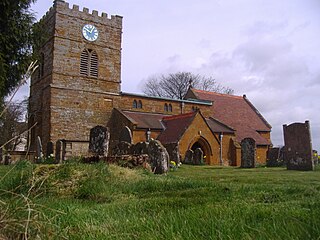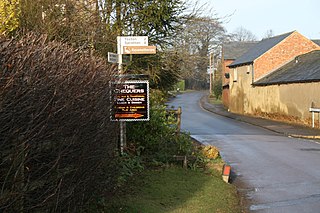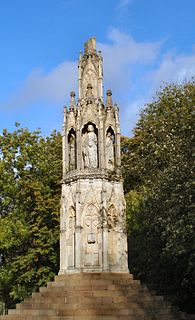
Northampton is a town and civil parish in the East Midlands region of England. It lies on the River Nene, 60 miles (97 km) north-west of London and 50 miles (80 km) south-east of Birmingham. As the county town of Northamptonshire, Northampton is the largest settlement within the unitary authority of West Northamptonshire. Northampton is one of the largest towns in England; it had a population of 212,100 at the 2011 census.

Long Buckby is a large village and civil parish in West Northamptonshire, England. In the 2011 census, the parish of Long Buckby, which includes the hamlet of Long Buckby Wharf, had a population of 3,913.

Brixworth is a large village and civil parish in West Northamptonshire, England. The 2001 census recorded a parish population of 5,162, increasing to 5,228 at the 2011 census. The village's All Saints' Church is of Anglo-Saxon origin.

Whilton is a village and a civil parish in the English county of Northamptonshire. The population at the 2011 Census was 271. The village is in West Northamptonshire. Whilton is 75 miles (121 km) northwest of London, 9+3⁄4 miles (15.7 km) west of Northampton and 15+1⁄2 miles (24.9 km) southeast of Rugby. The village lies 4+1⁄2 miles (7.2 km) east of the nearest town of Daventry. The nearest railway station is at Long Buckby for the Northampton loop of the West Coast Main Line which runs between Rugby, Northampton and London. The nearest airport is Birmingham Airport. Whilton gives its name to the nearby Whilton Locks and Whilton Marina on the Grand Union Canal.

Thornby is a village and civil parish in West Northamptonshire in England. It has a Manor house. At the time of the 2001 census, the parish's population was 162 people, increasing to 189 at the 2011 Census. The village is bisected by the A5199 road between Northampton and Leicester and about 11 miles (17.7 km) north-west of Northampton town centre. It is about 1½ miles south of a junction with the A14 road which joins the M1 Motorway and M6 junction at Catthorpe with Felixstowe, Suffolk.

Spratton is a village and civil parish in the English county of Northamptonshire. The local government authority is West Northamptonshire. Before changes in 2021 it was governed by Daventry District Council. At the time of the 2001 census, the parish's population was 1,099 people, increasing to 1,150 at the 2011 Census. Spratton is 7.1 miles north of Northampton, 6.5 miles from Long Buckby and 11.4 miles from Daventry. The village is situated on the A5199 road.

Ravensthorpe is a village and civil parish in West Northamptonshire in England. The village lies approximately midway between Northampton and Rugby. The M1 motorway is six miles west and the nearest railway station is at Long Buckby. At the time of the 2001 census, the parish's population was 656 people, including Coton but falling slightly to 646 at the 2011 census.

Harlestone is a small village and civil parish in West Northamptonshire, England. It is divided into two smaller settlements, Upper and Lower Harlestone. At the time of the 2001 census, the parish's population was 420 people, increasing to 445 at the 2011 Census.

East Haddon is a small village and civil parish in West Northamptonshire in England. The village is located eight miles from Northampton and is surrounded by the villages of Holdenby, Ravensthorpe and Long Buckby. The location between Northampton and Long Buckby provides useful train links towards London and Birmingham. At the time of the 2001 census, the parish's population was 651 people, falling to 643 at the 2011 census.

Dodford is a village in West Northamptonshire, England. Prior to local government changes in 2021 it was within the Weedon Ward of Daventry District. The village is just north of the A45 road 1½ miles west of Weedon. The population of the civil parish at the 2011 Census was 203. It is 3½ miles east of Daventry and ten miles west of Northampton. It is also close to junction 16 of the M1 motorway. The parish consists of some 1,384 acres and is bounded on the east by the A5 trunk road which is the old Roman road of Watling Street. Most of the village and parish sits astride the valley of an east-flowing stream which is a tributary of the River Nene.

Creaton is a village and civil parish in West Northamptonshire, England.

Charwelton is a village and civil parish about 5 miles (8 km) south of Daventry in Northamptonshire, England. The 2011 Census recorded the parish's population as 220.

Sulgrave is a village and civil parish in West Northamptonshire, England, about 5 miles (8 km) north of Brackley. The village is just south of a stream that rises in the parish and flows east to join the River Tove, a tributary of the Great Ouse.

Eydon is a village and civil parish in West Northamptonshire, about 8 miles (13 km) north-east of Banbury. The village is between 510 and 540 feet (160 m) above sea level on the east side of a hill, which rises to 580 feet (180 m) and is the highest point in the parish. The parish is bounded to the west by the River Cherwell, to the south by a stream that is one of its tributaries, and to the east and north by field boundaries.

Upton is a civil parish north-east of Kislingbury and south-west of Dallington, in Northamptonshire, England about 3.5 miles (6 km) west of Northampton town centre along the A4500 road. Formerly a scattered hamlet, it is now part of the town. The area west of Northampton is now a major area of expansion of the town and named Upton after the parish.

Hardingstone is a village in Northamptonshire, England. It is on the southern edge of Northampton, and now forms a suburb of the town. It is about 1 mile (2 km) from the town centre. The Newport Pagnell road separates the village from the nearby village of Wootton, which has also been absorbed into the urban area.

Dingley is a village and civil parish in Northamptonshire, England, located along the A427, about 2 miles (3.2 km) east of the nearest town, Market Harborough. It is also close to the A6 and near the border with Leicestershire. At the time of the 2001 census, the parish's population was 209 people, reducing to 194 at the 2011 census.

The village of Braunston Cleves or Fawcliff formerly stood north of the village of Braunston in the English county of Northamptonshire at its border with Warwickshire. It has long been a "lost village", having no standing buildings, but its position and the topography of its street and houses can be traced from the irregularities of the ground where it formerly stood. It was on the southwest slope of Cleve's Hill within Braunston parish: it appears to have been occupied in late Anglo-Saxon and early post-Conquest times. Nothing is known of why the village was deserted but it had certainly been destroyed by the 18th century.

The lost village of Canons Ashby is located in ground to the north of Canons Ashby House in the English county of Northamptonshire. Today there is still a small village around the house but this is located away from the original settlement, since the original settlement is now just field occupied by a herd of cows.
Ascebi is the name of the medieval village that is the lost settlement, Canons Ashby itself is currently not lost at all and people can easily find it on any map.

The lost village of Church Charwelton lies south-east of the village of Charwelton in the English county of Northamptonshire. Its site is on the north-east bank of the River Cherwell. The Jurassic Way long-distance footpath passes across the site.



















